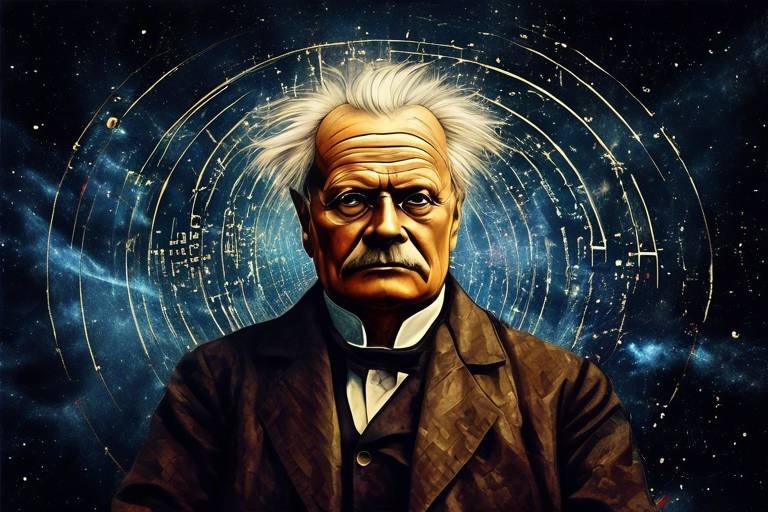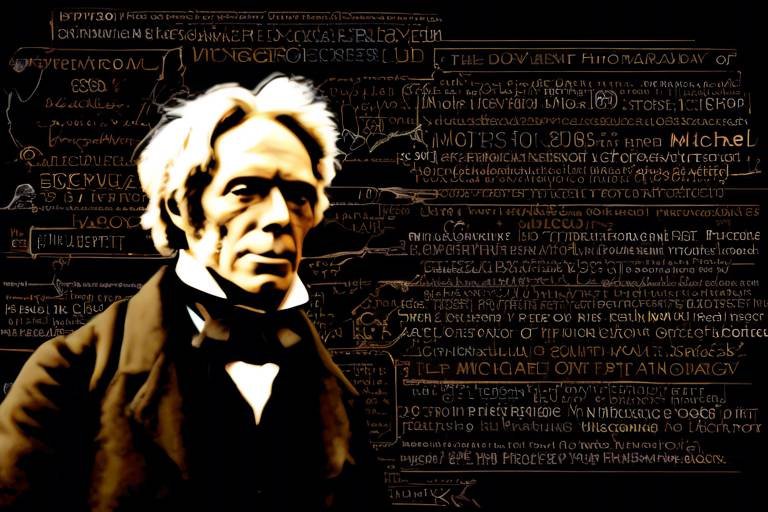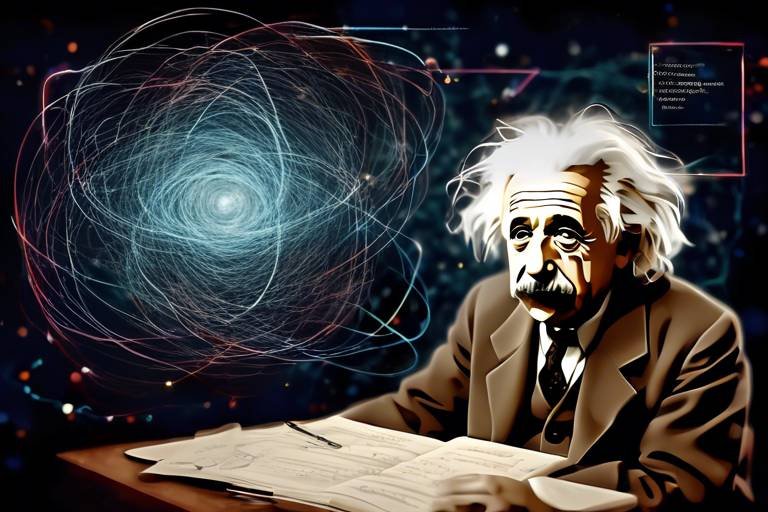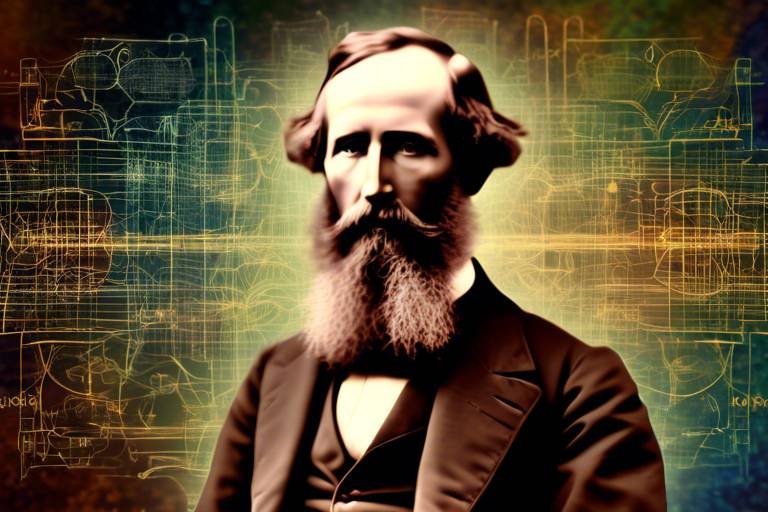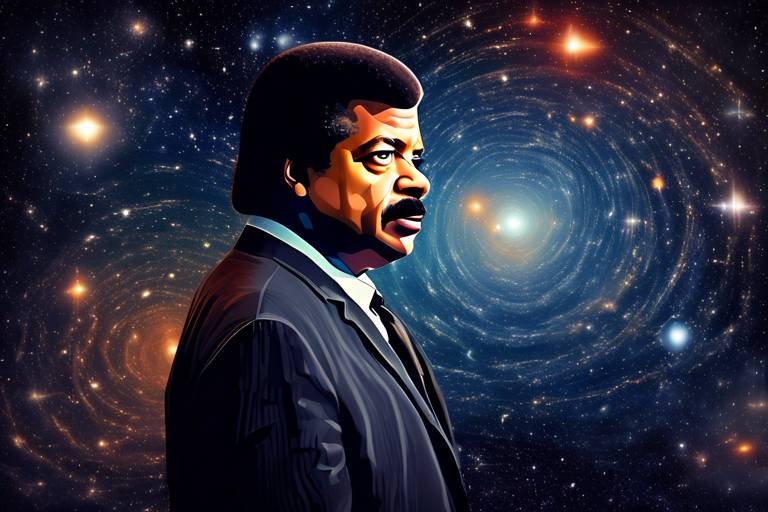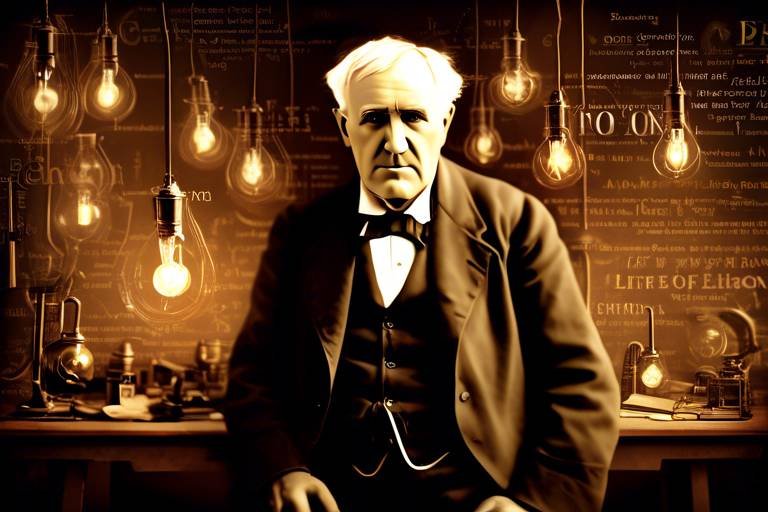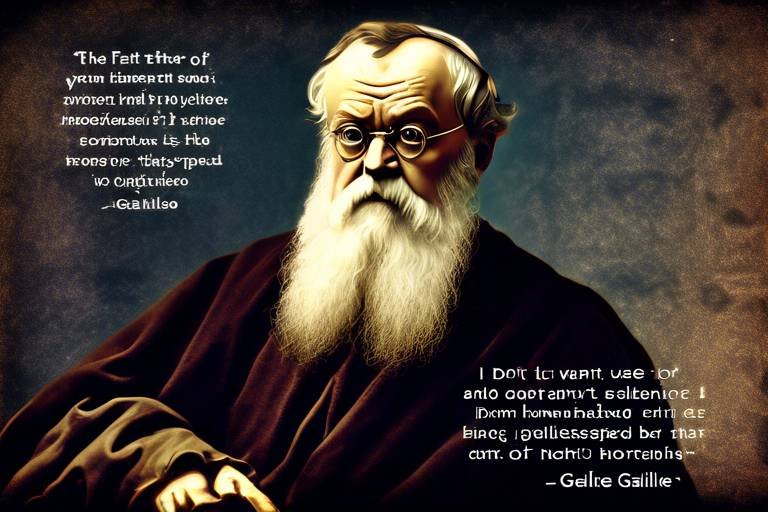The Theories of Hermann Minkowski in Spacetime
Hermann Minkowski, a name that resonates deeply within the realms of physics and mathematics, revolutionized our understanding of the universe through his groundbreaking theories on spacetime. Imagine a world where time and space are not separate entities but are intertwined in an elegant dance, influencing each other in ways that challenge our everyday perceptions. This is precisely what Minkowski proposed in the early 20th century, laying the foundation for what would become Einstein's theory of relativity. His innovative approach not only transformed theoretical physics but also sparked a new way of thinking about the cosmos.
Minkowski's concept of spacetime is a four-dimensional continuum that combines the three spatial dimensions with time, creating a unified framework to describe the motion of objects. This idea was nothing short of revolutionary; it allowed physicists to visualize and analyze the behavior of particles and light in a more comprehensive manner. Instead of viewing time as a mere backdrop against which events unfold, Minkowski placed it on equal footing with space, fundamentally altering our understanding of reality. Just as a painter uses a canvas to depict a scene, Minkowski provided a mathematical canvas for physicists to illustrate the universe's complexities.
The implications of Minkowski's theories extend far beyond theoretical musings. They have practical ramifications that permeate various fields, from cosmology to technology. For instance, the very principles derived from his work are essential for the functioning of GPS systems, which rely on precise timing to provide accurate location data. Without Minkowski's insights, our navigation systems would be far less reliable, illustrating how theoretical physics can have profound real-world applications.
As we delve deeper into Minkowski's contributions, we'll explore his mathematical formulations, particularly the Minkowski metric, which serves as a crucial tool for understanding the geometry of spacetime. This metric allows physicists to calculate distances between events in spacetime, providing a clearer picture of how time and space interact under various conditions. Furthermore, we will discuss phenomena such as time dilation and spatial contraction, both of which challenge our classical intuitions and reveal the strange yet fascinating nature of the universe.
In summary, Hermann Minkowski's theories on spacetime are not just abstract concepts; they are vital frameworks that help us comprehend the complexities of the universe. His work has paved the way for modern physics, influencing both theoretical frameworks and experimental approaches, and continues to resonate in fields like cosmology and quantum physics. As we journey through the intricacies of his ideas, we will uncover the profound impact they have had on our understanding of reality itself.
- What is the main idea behind Minkowski's spacetime? Minkowski's spacetime combines time and three-dimensional space into a single four-dimensional continuum, fundamentally changing our understanding of motion and the universe.
- How does the Minkowski metric work? The Minkowski metric is a mathematical tool that helps calculate distances between events in spacetime, essential for analyzing relativistic effects.
- What are the implications of time dilation? Time dilation implies that time passes at different rates for observers in relative motion, greatly affecting technologies like GPS.
- How does Minkowski's work influence modern physics? Minkowski's theories laid the groundwork for Einstein's relativity and continue to impact various branches of physics, including cosmology and quantum mechanics.

Minkowski's Concept of Spacetime
Imagine a world where time and space are not separate entities, but rather intertwined in a beautiful tapestry of existence. This was the revolutionary vision that Hermann Minkowski introduced to the scientific community. In the early 20th century, Minkowski proposed that the universe is best understood as a four-dimensional continuum—a concept that seamlessly merges the three dimensions of space with the dimension of time. This groundbreaking idea transformed the way physicists conceptualized motion and the overall structure of the universe.
Before Minkowski, time was often viewed as a mere backdrop against which events unfolded—like a stage on which the play of life occurs. However, Minkowski's insight was akin to realizing that the stage itself is part of the performance. He illustrated that just as we can move through space, we also traverse through time, and both dimensions are interconnected. This profound shift in perspective was not just academic; it had real implications for how we understand the universe and our place within it.
To visualize this concept, think of spacetime as a fabric stretched across the cosmos. When massive objects like stars and planets exist within this fabric, they create curves and bends, much like a heavy ball placed on a trampoline. These curves dictate how objects move through space and time, leading to effects that challenge our classical intuitions. For instance, the closer you are to a massive object, the slower time passes relative to someone far away. This is not just theoretical; it's a reality we encounter in our universe.
Furthermore, Minkowski's work laid the groundwork for Einstein's theory of relativity. While Einstein provided the revolutionary equations, it was Minkowski who offered the geometric interpretation that allowed these equations to be visualized and understood. His spacetime diagrams became essential tools for physicists, providing a way to represent events in a two-dimensional plane, where one axis represents time and the other represents space. This visual approach makes it easier to grasp complex concepts such as simultaneity and causality.
In summary, Minkowski's concept of spacetime was not merely a theoretical construct; it was a transformative idea that reshaped our understanding of the universe. By merging space and time into a single continuum, he opened the door to new possibilities in physics and laid the foundation for many modern scientific advancements. His theories continue to resonate today, influencing everything from cosmology to our everyday understanding of how the universe operates.

The Minkowski Metric
The Minkowski metric serves as a cornerstone in the field of relativity, offering a mathematical framework that encapsulates the essence of spacetime. Imagine trying to measure the distance between two points not just in space, but also incorporating the dimension of time—this is precisely what Minkowski achieved. By merging the three spatial dimensions with time into a single four-dimensional continuum, he transformed how we perceive motion and the universe itself. The Minkowski metric is essentially a way to calculate the interval between events in spacetime, which is crucial for understanding how different observers perceive time and space.
At its core, the Minkowski metric is defined by the equation:
s² c²t² - x² - y² - z²
In this equation, s represents the spacetime interval, c is the speed of light, and x, y, z are the spatial coordinates, while t is the time coordinate. This formula is a game-changer because it shows that the spacetime interval s remains invariant, meaning it is the same for all observers, regardless of their relative motion. This property is what allows physicists to reconcile the differences in how time and space are experienced by observers in different frames of reference.
Furthermore, the Minkowski metric highlights the idea that time and space are interwoven in ways that classical physics could never fully capture. For instance, when two observers move relative to one another, they may disagree about the timing and sequence of events, yet the spacetime interval calculated using the Minkowski metric remains constant. This leads to some fascinating implications, such as time dilation and length contraction, which challenge our everyday intuitions about how we perceive time and space.
To further illustrate the concept, consider the following table that summarizes the key components of the Minkowski metric:
| Component | Description |
|---|---|
| s | Spacetime interval |
| c | Speed of light in a vacuum |
| t | Time coordinate |
| x, y, z | Spatial coordinates |
In essence, the Minkowski metric is not just a mathematical curiosity; it is a vital tool that reshapes our understanding of the universe. It allows physicists to analyze the effects of relativistic speeds on time and space, leading to groundbreaking advancements in technology and our comprehension of the cosmos. The implications of this metric extend beyond theoretical realms—its applications are seen in modern technologies such as GPS, where precise timing is crucial. Without the corrections derived from Minkowski's insights, our navigation systems would be far less accurate, demonstrating how deeply intertwined his contributions are with our everyday lives.

Time Dilation
Time dilation is one of those mind-bending concepts that really makes you stop and think about the nature of reality. Imagine you're on a spaceship zooming through the cosmos at a speed close to that of light. Meanwhile, your friend is back on Earth, sipping coffee and watching the clouds drift by. According to Minkowski's theories, time for you on that spaceship would be ticking at a different rate than for your friend. This isn't just science fiction; it's a real phenomenon that has been confirmed by numerous experiments.
So, what exactly causes this time dilation? It all boils down to the way we perceive time when we're moving at relativistic speeds. When you travel at a significant fraction of the speed of light, time appears to slow down for you compared to someone who is stationary. This is not just a trick of perception, but a fundamental aspect of how time and space are intertwined in Minkowski's four-dimensional spacetime continuum.
To illustrate this, let's consider an example involving two twins, often referred to as the twin paradox. One twin embarks on a journey to a distant star at near-light speed, while the other stays on Earth. When the traveling twin returns, they find that they have aged significantly less than their Earth-bound sibling. This scenario beautifully encapsulates the essence of time dilation, showing how relative motion can lead to different aging processes for two observers.
Here are a few key points to remember about time dilation:
- Relative Motion: Time dilation occurs only when two observers are in relative motion to one another.
- Speed Matters: The greater the speed, the more pronounced the time dilation effect.
- GPS Technology: Modern technology, like GPS satellites, must account for time dilation to provide accurate positioning information.
In practical terms, time dilation has significant implications for technologies we use every day. For instance, the Global Positioning System (GPS) relies on satellites orbiting Earth, which experience both velocity-based time dilation and gravitational time dilation due to their position in a weaker gravitational field compared to the surface of the Earth. Without correcting for these effects, GPS calculations would quickly become inaccurate, leading to errors in navigation that could be as much as several kilometers!
In summary, time dilation isn't just a quirky aspect of theoretical physics; it has real-world consequences that affect how we understand and navigate our universe. Minkowski's insights into spacetime have not only reshaped our understanding of time but have also paved the way for advancements in technology and our grasp of the cosmos.

Experimental Evidence
When it comes to the theories proposed by Hermann Minkowski, one of the most fascinating aspects is how they have been validated through real-world experiments. The concept of time dilation, a cornerstone of Minkowski's work, isn't just a theoretical idea floating in the ether; it has been confirmed by numerous experiments that showcase the interplay between speed, time, and the fabric of spacetime itself.
One of the most compelling pieces of evidence comes from experiments involving atomic clocks. These highly precise instruments have been taken aboard fast-moving jets, and the results have been nothing short of astonishing. When the planes return to their starting points, the clocks on board show a slight difference compared to those that remained stationary on the ground. This phenomenon aligns perfectly with Minkowski's predictions about how time behaves for observers in relative motion.
To illustrate this, consider the following table that summarizes some key experiments confirming time dilation:
| Experiment | Description | Findings |
|---|---|---|
| Hafele-Keating Experiment | Atomic clocks flown around the world on commercial flights. | Clocks on the planes lagged behind stationary clocks, confirming time dilation. |
| Muon Decay Experiment | Observation of muons created by cosmic rays in the atmosphere. | Muons lived longer than expected due to their high speeds, supporting time dilation. |
| GPS Satellite Accuracy | Adjustments made for time differences between satellites and ground clocks. | GPS systems require corrections for time dilation effects to provide accurate positioning. |
These experiments not only confirm Minkowski's theories but also highlight their practical implications in our daily lives. For instance, the Global Positioning System (GPS) is a perfect example of how time dilation is not just a theoretical construct but a necessity for modern technology. Without accounting for the differences in time experienced by satellites moving at high speeds relative to observers on Earth, GPS would quickly become inaccurate, leading to significant navigational errors.
Furthermore, the muon decay experiment showcases how particles moving close to the speed of light behave differently than we intuitively expect. Muons, which are unstable particles, should decay quickly, but when they are created in the upper atmosphere and travel toward the Earth's surface, they are observed to survive longer than anticipated. This is because, according to Minkowski's framework, their high velocity causes time to slow down for them relative to stationary observers on Earth.
In conclusion, the experimental evidence supporting Minkowski's theories is robust and multifaceted. From atomic clock experiments to the functioning of GPS technology, these real-world applications demonstrate the profound impact of Minkowski's contributions to our understanding of spacetime. The validation of his theories not only deepens our comprehension of the universe but also underscores the importance of theoretical physics in shaping our technological advancements.
- What is Minkowski's spacetime?
Minkowski's spacetime is a four-dimensional continuum that combines the three dimensions of space with time, providing a framework for understanding the relationship between space and time in the context of relativity. - How does time dilation affect us?
Time dilation affects how time is measured for objects in motion relative to stationary observers. This has practical implications, such as in GPS technology, where satellite clocks must account for time differences due to their speed and position in Earth's gravitational field. - What are Minkowski diagrams?
Minkowski diagrams are graphical representations of events in spacetime, illustrating how different observers perceive time and space. They are essential for visualizing the effects of relativity.

Practical Applications
Hermann Minkowski's theories on spacetime have far-reaching implications that extend well beyond theoretical physics. One of the most significant practical applications of his work is found in the realm of global positioning systems (GPS). You might wonder how your smartphone can pinpoint your location with such precision. The answer lies in the intricate dance between time dilation and the speed of satellites orbiting the Earth.
GPS satellites travel at high velocities and are also situated in a weaker gravitational field compared to us on the surface. According to Minkowski's insights, time runs differently for these satellites compared to clocks on Earth. To maintain accuracy, the clocks on these satellites are adjusted to account for both the effects of their speed and the gravitational time dilation they experience. This adjustment is not just a minor tweak; it’s essential for ensuring that the GPS system can provide accurate location data, which is crucial for everything from navigation to emergency services.
In addition to GPS, Minkowski's theories have practical applications in various fields, including telecommunications, particle physics, and even cosmology. For instance, in particle accelerators, scientists utilize Minkowski's framework to predict the outcomes of particle collisions, which occur at relativistic speeds. Understanding how time and space interact allows physicists to analyze the results of experiments with greater accuracy, leading to discoveries that push the boundaries of our knowledge.
Moreover, the principles derived from Minkowski's spacetime concept have implications for emerging technologies such as quantum computing and space travel. As we venture further into the cosmos, understanding the relativistic effects on time and space will be pivotal for long-duration space missions. Astronauts traveling at significant fractions of the speed of light could experience time differently than their counterparts on Earth, raising intriguing questions about aging and communication.
To summarize, the practical applications of Minkowski's theories are not merely academic; they are integral to the functioning of technologies that we rely on every day. From GPS systems that guide us to our destinations, to cutting-edge research in particle physics and the future of space exploration, Minkowski's insights into spacetime continue to shape our understanding of the universe and our place within it.
- What is the significance of Minkowski's spacetime concept?
Minkowski's spacetime concept integrates time and space into a single framework, revolutionizing how we understand motion and the universe. - How does time dilation affect GPS technology?
Time dilation affects GPS technology by requiring satellite clocks to be adjusted for differences in time experienced due to their speed and gravitational effects. - Are there other applications of Minkowski's theories?
Yes, Minkowski's theories are applied in various fields, including telecommunications, particle physics, and future space travel technologies.

Spatial Contraction
When we think about motion, we often picture objects moving through space, leaving behind a trail of their journey. But what if I told you that when an object travels at speeds approaching that of light, it doesn't just move through space; it actually *changes* the way it exists in that space? This phenomenon is known as , or length contraction, and it’s one of the most mind-bending aspects of Einstein’s theory of relativity, which was heavily influenced by Minkowski's groundbreaking ideas.
Spatial contraction refers to the way an object appears to shrink in length along the direction of its motion as it approaches relativistic speeds. Imagine you're watching a train zoom past you at nearly the speed of light. To your eyes, that train would look shorter than it does when it's at rest. This isn't just an optical illusion; it’s a real effect predicted by the mathematics of spacetime. In essence, as the speed of an object increases, the space it occupies contracts, leading to a fascinating interplay between speed, space, and perception.
Now, you might be wondering why this matters. Well, understanding spatial contraction is crucial for several reasons:
- Challenges Classical Intuition: It contradicts our everyday experiences where objects maintain their size regardless of speed. This can be hard to wrap our heads around!
- Implications for High-Speed Travel: As we venture into the realm of high-speed travel, whether it’s through theoretical spacecraft or particle accelerators, recognizing how objects behave at these speeds is essential.
- Foundational for Modern Physics: Spatial contraction is not just a quirky fact; it’s a fundamental aspect of how we understand the universe, impacting everything from astrophysics to quantum mechanics.
To visualize this concept, consider a simple example. Let’s say we have a spaceship that measures 100 meters in length when at rest. If it begins to travel at a significant fraction of the speed of light, say 0.8c (where c is the speed of light), observers on the ground would measure the spaceship's length to be shorter than 100 meters. The exact length can be calculated using the length contraction formula:
| Speed (v) | Rest Length (L0) | Contracted Length (L) |
|---|---|---|
| 0.8c | 100 m | 60 m |
This table illustrates how the contracted length (L) can be derived when the spaceship is moving at a significant fraction of the speed of light. It’s a perfect example of how Minkowski’s theories provide a framework for understanding these extraordinary phenomena.
In conclusion, spatial contraction is a remarkable aspect of the relativistic world that challenges our intuitive understanding of space and motion. It’s a vivid reminder that the universe operates on principles that can seem strange and counterintuitive, yet they are grounded in the mathematical elegance of Minkowski's spacetime. As we push the boundaries of physics and explore the cosmos, acknowledging and understanding these effects will be essential for future discoveries and innovations.
- What is spatial contraction? Spatial contraction is the phenomenon where an object appears shorter in the direction of motion when moving at relativistic speeds.
- Does spatial contraction affect all objects? Yes, all objects experience spatial contraction when they move at speeds close to the speed of light, but the effect is only significant at those high velocities.
- How is spatial contraction related to time dilation? Both phenomena arise from the principles of relativity and are interconnected aspects of how time and space behave at high speeds.
- Can we observe spatial contraction in everyday life? No, spatial contraction is negligible at everyday speeds and only becomes noticeable at speeds approaching that of light.

The Role of Minkowski Diagrams
Minkowski diagrams serve as a fascinating and powerful tool in the realm of relativity, allowing us to visualize the intricate relationship between time and space. Imagine trying to explain a complex dance where each dancer moves to their own rhythm; Minkowski diagrams provide the stage where we can see these movements in relation to one another. They are essentially two-dimensional graphs where time is represented on one axis and space on the other, and they help to illustrate how different observers perceive the same events in spacetime.
One of the most compelling aspects of Minkowski diagrams is their ability to clarify the concept of simultaneity. In our everyday experiences, we might assume that two events happening at the same time for one observer will be simultaneous for all observers. However, Minkowski diagrams reveal that this is not always the case in the relativistic world. Depending on the relative motion of observers, two events that are simultaneous for one observer may not be simultaneous for another. This leads us to a deeper understanding of causality and the nature of time itself.
Moreover, Minkowski diagrams are not just theoretical constructs; they have practical applications in various fields of physics. For instance, physicists use these diagrams to analyze particle collisions, where understanding the interactions between particles moving at high velocities is crucial. By plotting the trajectories of particles on a Minkowski diagram, researchers can visualize how different factors—such as speed and direction—affect the outcomes of these collisions.
To illustrate the utility of Minkowski diagrams, consider the following table that summarizes key features:
| Feature | Description |
|---|---|
| Axes | Time is plotted on the vertical axis, while space is on the horizontal axis. |
| World Lines | The paths taken by objects through spacetime are represented as lines. |
| Simultaneity | Different observers can perceive events as simultaneous or non-simultaneous based on their relative motion. |
| Causality | Helps visualize cause-and-effect relationships in relativistic contexts. |
In conclusion, Minkowski diagrams are more than just theoretical illustrations; they are essential tools that enhance our understanding of the universe. They allow physicists to explore the complex interplay between time and space, providing insights that challenge our classical intuitions. As we continue to delve into the mysteries of the cosmos, these diagrams will undoubtedly remain a vital part of our toolkit.
- What is a Minkowski diagram?
A Minkowski diagram is a graphical representation of events in spacetime, illustrating how different observers perceive time and space.
- How do Minkowski diagrams help in understanding relativity?
They clarify concepts such as simultaneity and causality, making it easier to visualize and analyze relativistic effects.
- Can Minkowski diagrams be used in practical applications?
Yes, they are widely used in theoretical physics to analyze particle collisions and other phenomena involving high-speed motion.

Understanding Events
In the realm of Minkowski's spacetime, the concept of an "event" is pivotal. An event is not just a moment in time; it is a specific occurrence that has both a location in space and a moment in time associated with it. Imagine you're at a concert: the moment the band starts playing is an event. It has coordinates in both time and space—where you are standing and when the music begins. This duality is crucial for understanding how different observers perceive the same event differently, depending on their relative motion.
Minkowski diagrams serve as a visual aid to grasp these events. They allow us to plot events on a two-dimensional graph where one axis represents time and the other represents space. By doing this, we can see how different observers, moving at different velocities, would interpret the timing and location of these events. For example, if two friends are watching the same concert but one is in the front row and the other is stuck in traffic, their perceptions of when the music starts might differ. This discrepancy is not just a matter of opinion; it’s a fundamental aspect of how spacetime works.
To illustrate this, consider the following table that summarizes the coordinates of an event as perceived by two observers:
| Observer | Time (seconds) | Space (meters) |
|---|---|---|
| Observer A (Front Row) | 0 | 0 |
| Observer B (Traffic) | 2 | 50 |
As shown in the table, Observer A perceives the event at the moment it occurs, while Observer B experiences a delay due to their movement through space. This leads us to a fascinating aspect of relativity: simultaneity is not absolute. What one observer sees as simultaneous may not be the same for another. This is where Minkowski's insights become revolutionary, as they challenge our intuitive understanding of time and space.
Furthermore, understanding events through Minkowski diagrams also helps clarify the concepts of causality and the light cone. The light cone represents the boundary of what could possibly influence or be influenced by an event. If an event occurs outside another's light cone, it means that the second event cannot affect or be affected by the first, reinforcing the idea that information cannot travel faster than light. This insight is crucial for understanding the fundamental limits of causality in our universe.
In essence, the understanding of events in Minkowski spacetime is not just an academic exercise; it reshapes our perception of reality. By visualizing how different observers perceive time and space, we can appreciate the complexities of the universe and the profound implications of Einstein's theory of relativity. So the next time you think about time, remember that it’s not as straightforward as it seems—it's a beautifully intricate dance between space and time that we are only beginning to understand.
- What is an event in Minkowski spacetime? An event is a specific occurrence that has both a location in space and a moment in time associated with it.
- How do Minkowski diagrams help in understanding events? They visually represent events on a graph, showing how different observers perceive timing and location based on their relative motion.
- What is simultaneity in the context of relativity? Simultaneity is the concept that events that are simultaneous for one observer may not be simultaneous for another, depending on their relative motion.
- What is a light cone? A light cone illustrates the limits of causality, showing which events can influence or be influenced by a given event based on the speed of light.

Applications in Physics
The implications of Hermann Minkowski's theories extend far beyond theoretical musings; they have become integral to various domains within physics. One of the most significant applications is in the realm of particle physics. When high-energy particles collide, understanding their behavior requires a solid grasp of relativistic principles, and Minkowski's formulations provide the necessary framework. By using Minkowski diagrams, physicists can visualize the interactions of particles in a way that transcends traditional three-dimensional thinking. These diagrams allow scientists to map out the paths of particles as they traverse through spacetime, helping to predict outcomes of collisions in particle accelerators.
Moreover, Minkowski's work is pivotal in the field of cosmology. The structure of the universe, its expansion, and the behavior of celestial bodies are all influenced by the principles of spacetime. For instance, when studying the cosmic microwave background radiation or the movement of galaxies, cosmologists utilize the Minkowski metric to account for the effects of gravity on spacetime curvature. This understanding is essential when formulating models of the universe's evolution, especially in the context of general relativity.
In addition to these theoretical applications, Minkowski's concepts also have practical implications in the field of astrophysics. The navigation of spacecraft, particularly those traveling at relativistic speeds, necessitates an understanding of both time dilation and spatial contraction. For example, when planning missions to distant planets, engineers must consider how time will be experienced differently on board the spacecraft compared to Earth. This consideration is crucial for accurate mission planning and communication with astronauts.
Furthermore, Minkowski's theories have found applications in technologies that rely on high-precision timing. One prominent example is the Global Positioning System (GPS). The satellites in orbit around Earth experience both gravitational time dilation and the effects of their high velocities. To maintain the accuracy of GPS calculations, engineers must apply corrections based on Minkowski's principles. Failure to account for these relativistic effects would result in significant errors in positioning data, demonstrating how Minkowski's ideas have practical, real-world consequences.
As we delve into the future, the relevance of Minkowski's work continues to grow. The exploration of quantum mechanics and its intersections with relativistic physics often leads back to the foundational concepts established by Minkowski. His theories challenge physicists to think beyond the confines of classical physics, encouraging a more holistic view of the universe that encompasses both the minuscule particles of quantum physics and the vast expanses of cosmology.
In summary, Minkowski's contributions are not merely academic; they are vital to our understanding of the universe and the development of technologies that shape our daily lives. Whether in the context of particle collisions, the navigation of spacecraft, or the precision of GPS systems, his ideas resonate through the fabric of modern physics.
- What is the significance of Minkowski's spacetime in modern physics?
Minkowski's spacetime provides a unified framework that combines space and time into a single continuum, essential for understanding relativity and the behavior of objects moving at high speeds. - How do Minkowski diagrams help in particle physics?
Minkowski diagrams allow physicists to visualize and analyze the interactions of particles in spacetime, helping to predict the outcomes of high-energy collisions. - What role does Minkowski's work play in GPS technology?
GPS technology relies on corrections for time dilation effects due to the high speeds and gravitational fields experienced by satellites, which are based on Minkowski's theories. - Can Minkowski's theories be applied to quantum mechanics?
Yes, Minkowski's ideas continue to influence research in quantum mechanics, particularly where it intersects with relativistic physics.

Impact on Modern Physics
Minkowski's theories have had a profound and lasting impact on the landscape of modern physics, reshaping our understanding of the universe in ways that were previously unimaginable. His innovative concept of spacetime, which integrates time and space into a single four-dimensional continuum, has become a foundational principle in both theoretical and experimental physics. This shift in perspective has not only influenced the development of Einstein's theory of relativity but has also paved the way for advancements in various fields, such as cosmology, quantum mechanics, and even the emerging theories of quantum gravity.
One of the most significant contributions of Minkowski's work is the way it has altered our understanding of motion and the nature of reality itself. Before Minkowski, time was often viewed as a separate entity from the three dimensions of space. However, by treating time as an integral part of the spatial framework, Minkowski provided a more comprehensive understanding of how objects move and interact in the universe. This has led to a reevaluation of fundamental concepts like simultaneity and causality, challenging the classical notions that had dominated physics for centuries.
Moreover, Minkowski's influence extends into practical applications that touch our daily lives. For example, technologies such as GPS rely heavily on the principles of time dilation and spatial contraction derived from his theories. Without accounting for these relativistic effects, the accuracy of satellite positioning would be severely compromised. This highlights how theoretical physics, once thought to be an abstract domain, has tangible implications in the real world.
In addition to its practical applications, Minkowski's work has also inspired numerous advancements in theoretical physics. The framework he established has been instrumental in the development of various models in cosmology, including the Big Bang theory and the study of black holes. By providing a mathematical structure to describe the fabric of the universe, Minkowski's ideas have allowed physicists to explore the complexities of cosmic phenomena with greater clarity.
Furthermore, Minkowski diagrams, which visually represent events in spacetime, have become essential tools for physicists. These diagrams not only aid in the understanding of relativistic effects but also facilitate the analysis of particle interactions and collisions at high energies. As research in particle physics continues to evolve, the utility of Minkowski's graphical representations remains invaluable.
In summary, the impact of Hermann Minkowski's theories on modern physics cannot be overstated. His contributions have fundamentally altered our perception of time and space, leading to significant advancements in both theoretical frameworks and practical applications. As we continue to explore the mysteries of the universe, Minkowski's legacy serves as a reminder of the profound interconnectedness of all physical phenomena.
- What is Minkowski spacetime?
Minkowski spacetime is a four-dimensional continuum that combines the three dimensions of space with time, allowing physicists to analyze events in a unified framework. - How did Minkowski's work influence Einstein?
Minkowski's ideas provided a mathematical foundation for Einstein's theory of relativity, helping to formalize the relationship between space and time. - What are Minkowski diagrams?
Minkowski diagrams are graphical representations that illustrate the relationship between time and space for different observers, making it easier to understand relativistic effects. - How does time dilation affect our daily lives?
Time dilation affects technologies like GPS, where adjustments must be made to account for the differences in time experienced by satellites moving at high speeds compared to observers on Earth.
Frequently Asked Questions
- What is Minkowski's concept of spacetime?
Minkowski's concept of spacetime revolutionized our understanding by merging the three dimensions of space with time into a four-dimensional continuum. This means that instead of viewing time and space as separate entities, they are interconnected, allowing for a more comprehensive understanding of how objects move and interact in the universe.
- How does the Minkowski metric work?
The Minkowski metric is a mathematical framework that allows us to calculate distances between events in spacetime. It provides essential tools for physicists to analyze how time and space are affected by relative motion, helping to explain phenomena such as time dilation and spatial contraction.
- What is time dilation, and why is it important?
Time dilation is the effect where time passes at different rates for observers in relative motion. This concept is crucial, especially in high-speed travel scenarios and technologies like GPS, where satellite clocks must account for these relativistic effects to ensure accurate positioning.
- Can you give an example of experimental evidence for time dilation?
Absolutely! One of the most notable experiments involved atomic clocks placed on fast-moving jets. When compared to stationary clocks, the clocks on the jets showed a measurable difference in time, confirming Minkowski's predictions about time dilation and its effects on time perception.
- What is spatial contraction?
Spatial contraction, or length contraction, occurs when an object moves at speeds close to the speed of light, making it appear shorter along the direction of motion. This challenges our classical understanding of space and emphasizes how relativistic speeds can alter our perception of physical dimensions.
- How do Minkowski diagrams help in understanding spacetime?
Minkowski diagrams are visual tools that represent events in spacetime, helping to illustrate how different observers perceive time and space. They clarify concepts like simultaneity and causality, making it easier to grasp the complexities of relativistic physics.
- What impact did Minkowski's theories have on modern physics?
Minkowski's theories laid the foundational groundwork for modern physics, influencing both theoretical frameworks and experimental methods. His ideas continue to resonate in various fields, including cosmology and quantum physics, shaping our current understanding of the universe.

